
5GAA Announces Deployment of LTE-V2X by 2020
The C-V2X technology tested, validated, and commercially available in vehicles in 2020
The inclusion of cellular communication technologies (V2N – Vehicle2Network) into vehicles (i.e. “Connected Cars”) has been extremely successful, and since early deployments in the last couple of decades, we continue to see an expansion of how these technologies can deliver benefits for the vehicle, the driver, and other participants in the transportation ecosystem.
At present, the automotive manufacturing members of 5GAA operate more than 20 million Connected Cars that have the ability to connect to cellular networks (V2N). This V2N connection is used for a wide variety of application domains including telematics, infotainment, traffic optimization, as well as for safety applications like the recognition of slow or stationary vehicle(s) and warnings for such events as traffic jam ahead, road works and other traffic infrastructure related information, inclement weather conditions, emergency brake light and other hazard warnings. The current understanding, also based on the European C-ITS Platform Final Report, is that the nature of these warning messages is informational and the driver is responsible at all times.
As defined in the approved 3GPP Release 14 in June 2017, cellular networks are able to take another evolutionary step in the pathway to broaden the reach and applicability of benefits. ![]() In particular, this release addresses the challenges of delivering increased data volume, managing greater scale in connected devices, significantly reduced latency and providing higher levels of reliability. These defined attributes and an advanced architecture provide unprecedented support for the support of safety-critical communications, referred to as Cellular Vehicle to Everything (Cellular-V2X or C-V2X). In addition to such V2N enhancements, which rely on existing cellular networks, 3GPP Release-14 introduces the ability to support short-range communications between vehicles (V2V) and vehicle and road side infrastructure (V2I and I2V) without requiring any cellular network coverage.
In particular, this release addresses the challenges of delivering increased data volume, managing greater scale in connected devices, significantly reduced latency and providing higher levels of reliability. These defined attributes and an advanced architecture provide unprecedented support for the support of safety-critical communications, referred to as Cellular Vehicle to Everything (Cellular-V2X or C-V2X). In addition to such V2N enhancements, which rely on existing cellular networks, 3GPP Release-14 introduces the ability to support short-range communications between vehicles (V2V) and vehicle and road side infrastructure (V2I and I2V) without requiring any cellular network coverage.
3GPP Release 14 including C-V2X is also a key step to the next generation of cellular technology, 5G. Naturally C-V2X is already on a backwards compatible evolution path with enhancements being specified beginning with 3GPP Release 15.
The members of 5GAA are wholly committed to collaborating to ensure that the potential of the C-V2X technology is realized. This includes leading efforts to address key technical and regulatory issues, as well as integrating vehicle platforms with advanced cellular connectivity, networking and computing solutions.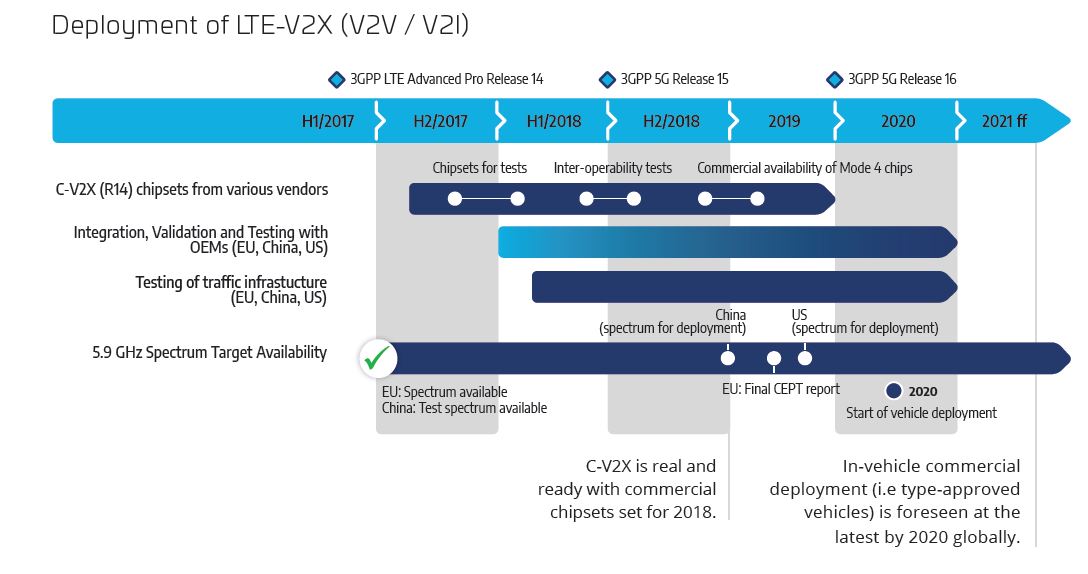
It is with this cooperation, collaboration, and commitment that 5GAA members continue to work to ensure that C-V2X technology is tested, validated, and commercially available in vehicles in 2020.
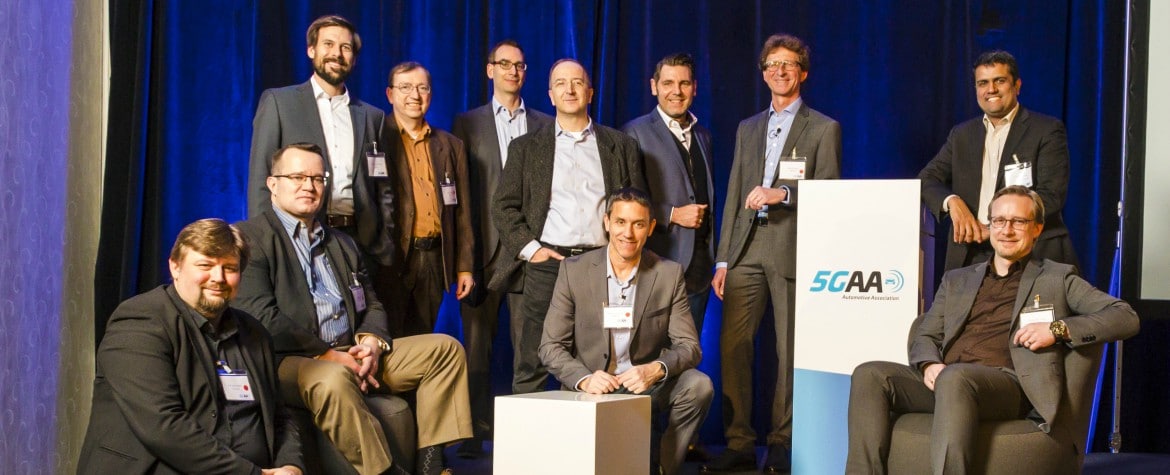
C-V2X & Edge Computing: The Winning Technologies for Connected Vehicles and Autonomous Driving
Munich, Germany – On 8th February 2018, the 5G Automotive Association lead a successful Open Workshop on “Edge Computing and V2X“. The workshop – open to both 5GAA members and non-members – aimed to provide a discussion platform for the wide range of stakeholder advocating for the evolution of cloud computing in the automotive sector.
Edge Computing offers cloud computing capabilities at the edge of the network. Several demonstrated C-V2X use case trials have already proven the potential of Edge Computing to serve real C-V2X scenarios. 5GAA considers Edge Computing as one of the key supporting technologies for many of the foreseen V2X services for connected vehicles and for Autonomous Driving.
The Munich workshop brought together industry stakeholders from car OEMs, OEM suppliers, road and mobile network operators to edge computing technology vendors. Edge Computing was covered from various perspectives, illustrating its potential to further expand the competitiveness of C-V2X as the technology of choice for C-ITS. The unique position of 5GAA in the technology and solutions development was again highlighted.
The automotive sector, including OEM suppliers and car makers, shared their thinking and experiences with the technology. The event culminated in the panel discussion which included consideration of use cases and requirements and on how to best utilise the networks and Edge Computing for C-V2X.
Finally, the participating companies concluded a common understanding on the way forward:
- Edge Computing has a great value proposition for C-V2X and its evolution, as it further increases the competitiveness of C-V2X and its infrastructure component (LTE-Uu) over the alternative ITS-G5 technology.
- Technical discussions are to continue in the 5GAA working groups; further collaboration with standardization bodies is encouraged to continue and expand.
- Future workshops similar to this one can be considered, e.g. again collocated with a future 5GAA meeting.
About the 5GAA
The 5GAA is a cross-industry association between the cellular and automotive industries to develop, test and promote communications solutions, initiate their standardisation and accelerate their commercial availability and global market penetration, to address society’s connected mobility and road safety needs with applications such as automated driving, ubiquitous access to services and integration into smart city and intelligent transportation.
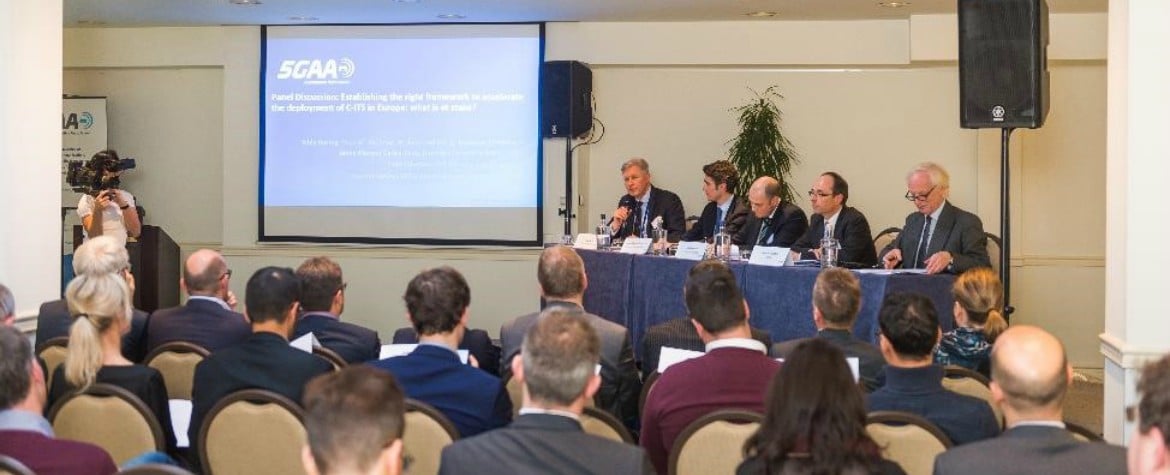
Peaceful coexistence of C-V2X and ITS-G5 technology offers the highest net benefits for Europe
5GAA and EU policymakers discuss future of 5G for connected and automated vehicles
12 December 2017, Brussels, Belgium – The 5G Automotive Association (5GAA), a cross-industry association of the telecoms and automotive industry, held a policy debate on Tuesday 5 December in Brussels to discuss the concrete actions necessary to implement 5G connected and automated vehicles in Europe. A recurring theme in Tuesday’s debate was the cohesive development and implementation of cellular “vehicle to everything” (C-V2X) technology, the technology that will enable automobiles to communicate via cellular networks to other connected devices but also the possibility of ad-hoc communication without any cellular network involvement (e.g. in case of weak coverage). Policymakers and industry face the ongoing challenge of creating a cohesive framework that enables private sector innovation while ensuring a safe and economically viable rollout of new technologies.
Attendees heard from a wide range from various European political and administrative representatives, including Eddy Hartog, EC Head of Unit Smart Mobility and Living, Attila Benedek (Adviser to István Ujhelyi MEP, rapporteur on European C-ITS Strategy), Jaime Moreno García-Cano of the Spanish traffic authority or Andreas Geiss, EC Head of Unit for Spectrum Policy. 5GAA was represented by its Secretary, Markus Dillinger of Huawei and board members, Luke Ibbetson of Vodafone, Joachim Göthel of BMW, Rainer Krumrein of Daimler, and Friedhelm Ramme of Ericsson.
The debate coincides with the Commission’s ongoing public consultation on its European Strategy on Cooperative Intelligent Transport Systems (C-ITS), which runs through January 5, 2018. C-V2X technology stands to significantly improve road safety and facilitate traffic flows in the EU. Ultimately, the benefits of this technology across the EU could save the several billion euros that are lost every year to traffic accidents and congested roadways.
Markus Dillinger, 5GAA Secretary and Member of the Executive Committee: “5GAA was founded to underscore the urgency in developing technology that makes our roads safer and smarter. Today’s debate brought together public and private sector stakeholders to discuss the capabilities of such technology as well as the acceleration of creating a regulatory framework in which the industry can work.”
During the event, analysts from Analysys Mason and SBD Automotive presented the findings of a cost-benefit analysis of implementing the C-V2X technology. The socio-economic returns of deployment of C-ITS systems may amount to EUR 43 billion by 2035 in Europe, if both C-V2X and the Wi-Fi Standard IEEE 802.11p are able to co-exist in the 5.9GHz spectrum band. The 5GAA also presented a study assessing the road safety benefits of LTE–V2X (PC-5) and IEEE 802.11p in the EU, which indicates that LTE-V2X (PC5) outperforms 802.11p in reducing fatalities and serious injuries. In addition, it demonstrates that the absence of interoperability between technologies is unlikely to present a substantive barrier to the reduction of road accidents in the short to medium term. Bill McKinley, 5GAA rapporteur on tests and trials, and Rainer Krumrein of Daimler also presented 5GAA’s perspective on C-V2X performance and future capabilities.
The event culminated in a panel discussion to discuss the right framework to accelerate the deployment of the C-ITS across Europe. Particular attention was given to short-range communications in the 5.9 GHz band and the four guiding policy principles established by the European Commission: uncompromised safety services for all users in case of multiple technologies implementation, technology neutrality of spectrum regulation, efficient spectrum use and introduction in the longer-term of 5G for the further development of cooperative, connected and automated mobility.
Luke Ibbetson, R&D Director Vodafone Group and member of 5GAA: “Both C-V2X and ITS-G5 technologies should peacefully co-exist in the 5.9 GHz band. The socio-economic and road safety studies presented at this event indicate that co-existence offers the highest net benefits for the European economy, amounting to EUR 43 billion by 2035.”
Joachim Göthel, Senior Manager Project 5G-Alliance of BMW and member of 5GAA: “C-V2X offers a strong evolution path to 5G which is absolutely essential to enable full connected and automated driving in the future, while enabling a fast roll-out for many functionalities in the very short-term, utilizing existing cellular networks.”
The presentations made during the Workshop are downloadable here below:
1. Introductory 5GAA Presentation
2. Presentation on cellular V2X socio-economic benefit study
3. LTE-V2X (PC5) and road safety in the EU
4. 5GAA Presentation Trials
5. Daimler view on V2X – 5GAA Policy Debate
About the 5GAA
The 5GAA is a cross-industry association between the cellular and automotive industries to develop, test and promote communications solutions, initiate their standardisation and accelerate their commercial availability and global market penetration, to address society’s connected mobility and road safety needs with applications such as automated driving, ubiquitous access to services and integration into smart city and intelligent transportation.
Pictures credit © Thomas Blairon, 2017. Reproduction of this image is authorised, provided the source is acknowledged

5GAA Study | The cost-benefit analysis on cellular vehicle-to-everything (C-V2X) technology and its evolution to 5G-V2X
This report, authored by independent telecoms, media and technology consultants Analysys Mason together with automotive consultancy SBD Automotive, assesses the benefits of cellular vehicle to everything (C‑V2X) technology for delivery of vehicle-to-everything (V2X) communication. The report, which has a focus on the benefits of such solutions in Europe, uses qualitative evidence, and describes quantitative cost–benefit analysis that the consultants have undertaken, relating to deployment of C‑V2X.
The purpose of the study has been to examine qualitative evidence and perform quantitative analysis, regarding the net benefits of C‑V2X. Quantitative analysis is focused on the European market, where the European Commission (EC) is currently undertaking a public consultation on the deployment of cooperative intelligent transport systems (C‑ITS).
Read the full study here.
As part of this study, primary research has been conducted to elicit views from the mobile and automotive industries on the benefits of C‑V2X. One-to-one interviews with companies involved in the 5GAA were held, in order to identify several key benefits, as summarised in Figure 1.1 below.
A snippet from the report featuring the benefits of C-V2X [Source: Analysys Mason, 2017]
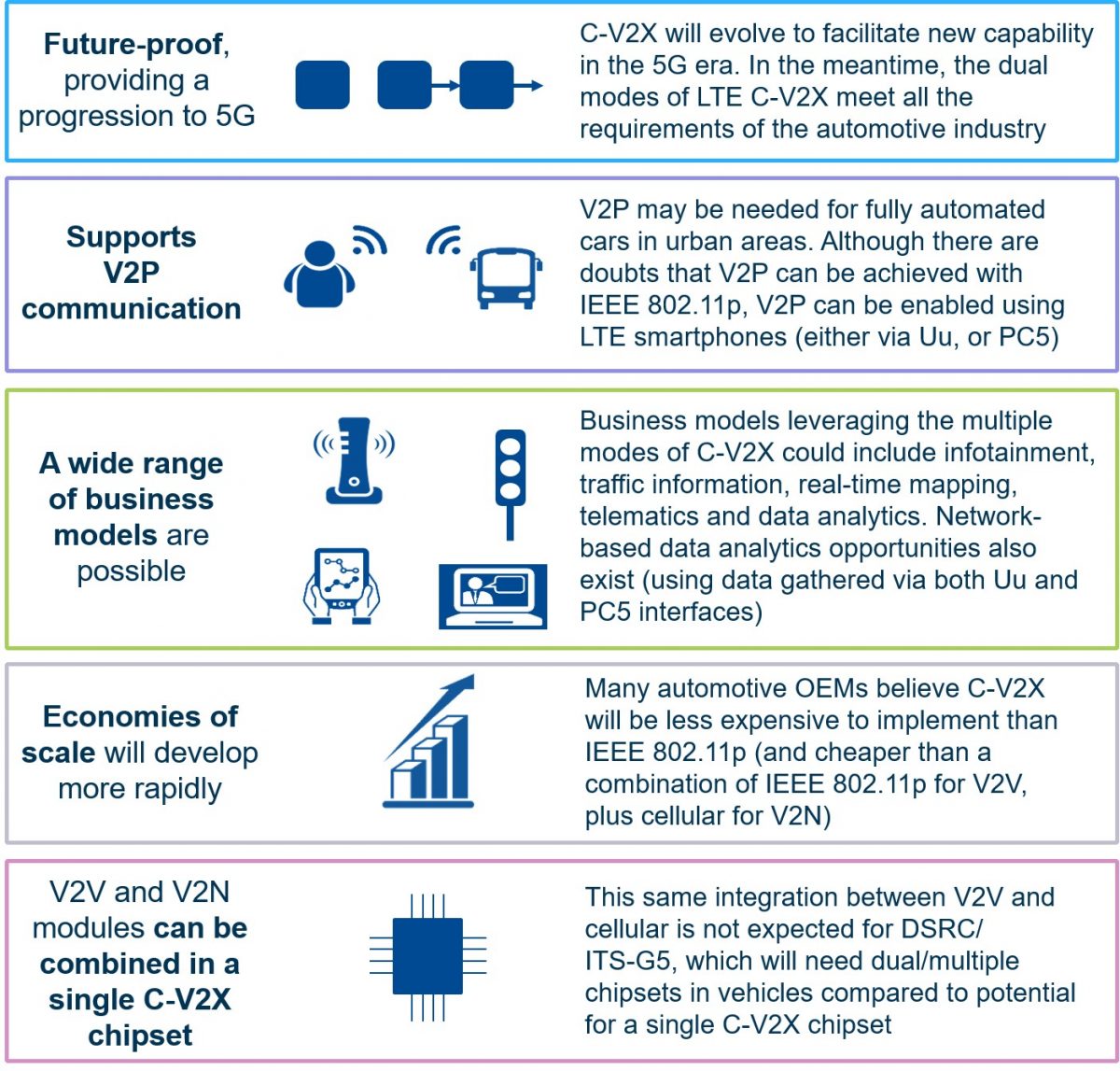

An assessment of LTE-V2X (PC5) and 802.11p direct communications technologies for improved road safety in the EU
This report by the 5G Automotive Alliance (5GAA) presents a quantitative analysis of the ability of Cooperative Intelligent Transport Systems using short-range ad hoc/direct communications to reduce the number of fatalities/serious injuries caused by motoring accidents in the EU. In this context, the study estimates the number of accidents avoided over time through the use of two short-range wireless technologies, 3GPP LTE-V2X (PC5) and IEEE 802.11p, examining their respective performance and projected take-up among road users. The modelling underlying this report has been peer-reviewed and validated by the technology and policy consultancy, Ricardo.
Specifically, two standardised C-ITS short-range technologies are compared for the purposes of this report, namely 3GPP LTE-V2X PC5 (also known as LTE side-link) and IEEE 802.11p (also known as DSRC or ITS-G5), both operating in the 5.9 GHz band for the provision of direct communications between road users. It should be noted that additional reductions in the number of fatalities and serious injuries are possible via longer-range C-ITS communications enabled through interactions with a LTE cellular network, but that these are not considered in this report. Hence, the analysis is limited to LTE-V2X (PC5) only, in comparison to 802.11p.
This study examines and compares two independent counter-factual scenarios: one where LTE-V2X (PC5) is the only deployed C-ITS technology, and the other where 802.11p is the only deployed C-ITS technology.
We consider, as a baseline, the existing and future projected statistics for road traffic fatalities and serious injuries in the EU. We then evaluate the reduction in the number of fatalities and serious injuries which may occur as a result of C-ITS direct communications between road users, by modelling:
- The expected take-up (penetration) of LTE-V2X (PC5) and 802.11p among road users in the EU over time (including vehicles, motorcycles, bicycles and pedestrians), and
- the radio link performance of LTE-V2X (PC5) and 802.11p in successfully delivering actionable warning messages between road users in a number of collision scenarios.
We identify the following conclusions and recommendations from the results of this report:
- The study indicates that LTE-V2X (PC5) outperforms 802.11p in reducing fatalities and serious injuries on the EU’s roads. This is due to a combination of the superior performance of LTE-V2X (PC5) at the radio link level for ad hoc/direct communications between road users, and the market led conditions which better favour the deployment of LTE-V2X in vehicles and in smartphones, and include a clear evolutionary path towards 5G-V2X. For these reasons, it is essential that EU regulations remain technology neutral and do not hinder the deployment of LTE-V2X (PC5) in favour of 802.11p for the provision of direct communications among vehicles and between vehicles and vulnerable road users.
- An absence of interoperability at radio link level between LTE-V2X (PC5) and 802.11p is unlikely to present a substantive barrier to the reduction of road accidents in the EU in the short to medium term. The relatively low penetration of C-ITS technologies in vehicles in the first half of the next decade (and perhaps even later) means that a vehicle equipped with LTE-V2X (PC5) or 802.11p is far more likely to collide with a vehicle that is not equipped with C-ITS technologies at all – indeed it is not until the middle of the next decade that penetration rates are expected to reach a level which results in significant impacts on accident rates. Any regulations which mandate LTE-V2X (PC5) to be backward interoperable with 802.11p will therefore have only a limited effect in the early years of deployment pre-2025. Such regulations may run the risk of unnecessarily distorting the market in favour of 802.11p, thereby obstructing the adoption of LTE-V2X (PC5) and resulting in greater road fatalities and injuries in the longer term.
Read the full study here.

Socio-economic benefits of cellular vehicle-to-everything could amount to 43 Billion Euros by 2035
Brussels, 05th December 2017 – The 5GAA today published a report, authored by independent telecoms, media and technology consultants Analysys Mason together with automotive consultancy SBD Automotive, which assesses the benefits of cellular vehicle to everything (C‑V2X) technology for delivery of vehicle-to-everything (V2X) communication. The report, which has a focus on the benefits of such solutions in Europe, uses qualitative evidence, and describes quantitative cost–benefit analysis that the consultants have undertaken, relating to deployment of C‑V2X.
Publication of the report coincides with policy development on V2X, and use of the 5.9GHz band, in the European Union, where the European Commission is currently undertaking a public consultation on deployment of cooperative intelligent transport systems (C‑ITS).
The study concludes that the deployment of C-ITS systems is beneficial at the European Union level. Net benefits that could be accrued in Europe are estimated to be in the range of EUR20 billion to EUR43 billion in 2035 (with the highest benefits coming from increased road safety, and traffic efficiency), across the four scenarios modelled.
The most favourable scenario of those modelled in the study (amounting to EUR 43 billion net benefits) is where the potential for rapid penetration and economies of scale for C-V2X is maximised and both C-V2X and the Wi-Fi Standard IEEE 802.11p are able to co-exist in the 5.9GHz spectrum band. Such benefits do not arise in a scenario where the use of IEEE 802.11p is mandated for C-ITS services, which would result in less than half these expected net benefits (EUR 20 billion).
The study also indicates benefits of C-V2X for the European market lie in its deployment flexibility, with the ability to provide coverage for both short range and wide area applications, and certainty of future evolution to 5G, potentially facilitating earlier deployment as well as after-market deployment (e.g. V2X services provided in vehicles via a smartphone or other after-market device with C-V2X connectivity).
Reduced infrastructure deployment costs are a further key benefit of C-V2X, from the potential to re-use existing mobile infrastructure, and thus leveraging cellular technology integration and economies of scale, rather than building independently operated roadside infrastructure.
Christoph Voigt, 5GAA Chairman comments: “C-V2X will be fundamental to the deployment of cooperative intelligent transport systems. The benefits highlighted is this report indisputably demonstrate that this technology will lead to major improvements in driving and road safety. It further highlights that the European Commission should take a technology neutral approach and not limit these benefits by mandating the use of the Wi-Fi standard IEEE 802.11p”
The socio-economic benefits study on C-V2X can be found here.
Separately, the 5GAA has also today published a study which carries out a quantitative analysis of LTE–V2X (PC-5) and IEEE 802.11p technologies for short-range ad hoc/direct communications in reducing fatalities and serious injuries caused by motoring accidents in the EU. The modelling underlying this report was peer-reviewed and validated by the technology and policy consultancy, Ricardo. The study find that LTE-V2X (PC5) outperforms 802.11p in reducing fatalities and serious injuries on the EU’s roads. The 5GAA’s study on an assessment of LTE-V2X (PC5) and 802.11p direct communications technologies for improved road safety in the EU can be found here.
About C-V2X
V2X allows vehicles to communicate with each other and the wider transport ecosystem. It will potentially complement on-board sensors by providing enhanced information (such as data from other vehicles) over a longer range.
C‑V2X is a technology developed by the Third Generation Partnership Project (3GPP) to deliver V2X services, using two modes of communication:
- a direct vehicle-to-vehicle mode (called ‘PC5’ in 3GPP specifications) and
- a network communications interface (called ‘Uu’ in 3GPP specifications) for vehicle-to-network (V2N) communication via existing mobile networks.
Download Press Release here.
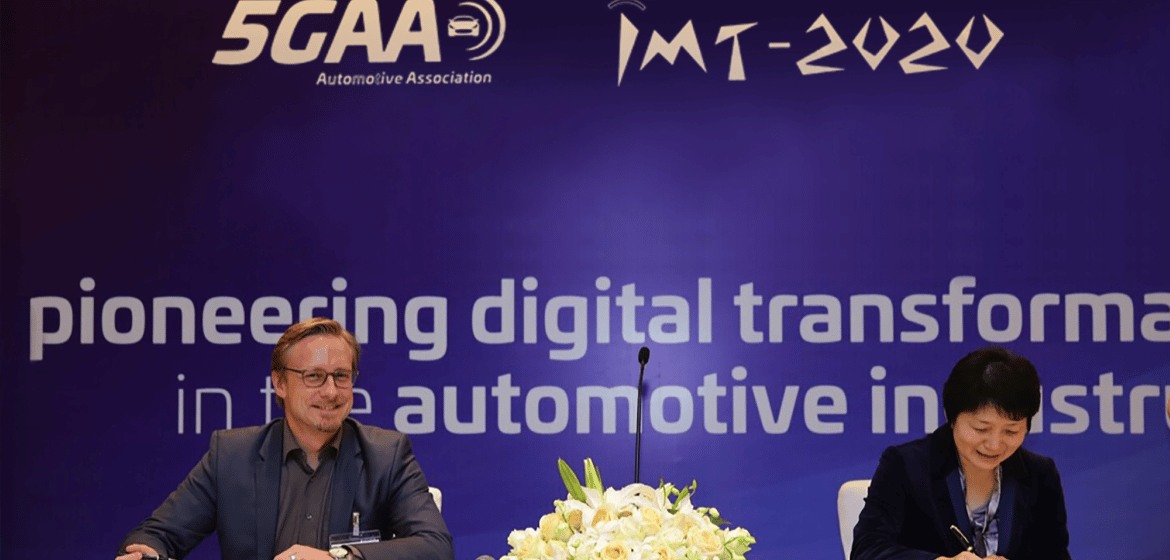
Co-operating to build a better Mobility Ecosystem: 5GAA and IMT2020 Present their Partnership
The 5G Automotive Association (5GAA) is delighted to announce that it is embarking on a new partnership with the IMT-2020 (5G) Promotion Group.
On 16 November 2017, in Shanghai, both parties have signed a Memorandum of Understanding in order to foster cooperation in the field of connected and autonomous driving solutions. This exciting journey of collaboration will also be a unique opportunity to pool resources in technology research and related use cases on a global scale.
Both organisations are advocates for the accelerated development of enhanced mobile communication systems between all road users and vehicles. The focus technologies for both associations are LTE-V2X and 5G-V2X. The 5GAA and IMT-2020 (5G) Promotion Group will harness their joint expertise on a range of projects, such as:
- Further conducting technical research on LTE-V2X and 5G-V2X
- Ensuring the promotion of the applications of 5G based V2X solutions
Since its launch in September 2016, 5GAA has grown exponentially worldwide. Over 60 industry leaders from the automotive, technology and telecommunications industries have teamed up to accelerate C-V2X technology development and its evolution to 5G-V2X for enhanced safety, automated driving and connected mobility. Together, 5GAA members are building a safer, more sustainable and connected transport ecosystem.
The Chairman of 5GAA, Christoph Voigt, is confident that both organisations’ hold a bright future of collaboration together: “5GAA was created to connect the telecom industry and vehicle manufacturers to develop 360-degree solutions for safer and more sustainable mobility systems. We look forward to working with IMT-2020 to define the requirements of C-V2X and to create a successful V2X ecosystem”.
IMT-2020 was established in February 2013. It is the major platform for 5G technology innovation, industry promotion and international cooperation in China. IMT-2020 C-V2X Working Group is established by IMT-2020 Expert Committee in April 2017, who conduct technical research on LTE-V2X and 5G-V2X innovation. Its members include leading operators, vendors, universities and research institutes in the telecommunication and automotive industries.
Wang Zhiqin, Chairman of IMT-2020 welcomed the signature of the Memorandum of Understanding between both organisations: ”IMT-2020 is the major platform for 5G technology innovation, industry promotion and international cooperation in China, and IMT-2020 C-V2X Working Group is responsible for industry integration among ICT, automobile, transportation and etc.. IMT-2020 and 5GAA have a number of partners and working interests in common, we are glad to cooperate with 5GAA together to ensure the successful development and commercialization of C-V2X and future 5G automotive services”.

Bright Regulatory Trends of C-V2X in Asia Pacific Region
Shanghai, China – On 16 November, The 5G Automotive Association (5GAA) hosted its Second General Assembly. Following announcements of the association’s progress and growth worldwide, 5GAA inaugurated the Asia Pacific Roundtable. Here, regulators from China and South Korea joined the discussion, sharing industry trends for the Internet of Vehicles and future Intelligent Transport Systems, as well as a number of real-life demonstrations of technology that is being developed in this region.
5GAA is a unique organisation on the global stage: with leading members of the automotive and telecommunications industry as founders. The association aims to pioneer digital transformation on our roads, creating a safer and more sustainable road environment for all.
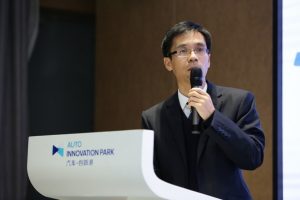
At the Asia Pacific Roundtable, Mr. He Guangjin from the Chinese TMRI (Traffic Management Research Institution) of MPS (Ministry of Public Security), presented the demonstration made at WIOT 2017 (World Internet of Things Expo) in Wuxi. This was the first demonstration from the Chinese public security industry where the LTE-V2X technology was employed. Additionally, it was so a premiere for the official traffic management system to be opened to vehicles on open roads. TMR also announced its plan to build a larger LTE-V2X pre-commercial trial including 20 to 50 intersections in 2018, to verify the broadcasting of real-time traffic conditions of intersections and the reception of information transmitted from vehicles. Additionally, TMRI is actively working on industry and national standards such as “Road Traffic Signal Controller I2V Information Distribution Interface Specifications”, “Adaptive Verification Management Regulation of Intelligent & Connected Vehicles (ICV) on Public Roads”, etc.

Dr. Cen Yanqing from the Chinese RIOH (Research Institution of Highway) of the MOT (Ministry of Transport) shared the important progress of the MOT. The ministry is paying close attention to automated driving and has already set up a dedicated working group to coordinate the corresponding ministries and guide the work on automated driving technology. In order to achieve automated driving, it is not sufficient to equip autonomous vehicles but it’s also needed to have an intelligent reformation of the road infrastructure and vehicle-to-road, vehicle-to-vehicle, vehicle-to-person communication and interaction in an effective way. To further promote the automated driving, the Ministry of Transport has built test zone for commercial vehicles verification in Tongzhou, Beijing, including specific scenarios e.g. ramps, intersections, and traffic lights.
When Dr. Cen was asked about whether MOT will mandate any technical specifications, he clarified there is no mandatory regulation so far. The MOT – as a department which uses technology – is opened to the utilisation of the V2X technology, but will select the best and most efficient technology eventually, he said. He also claimed that the MOT would support some of the Chinese telecommunication corporate contributions such as CMCC, Huawei, and Datang. Finally, he declared “we cannot implement two technologies but only one”.
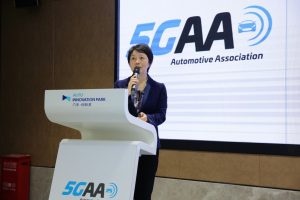
•Vice President of the China Academy of Information and Communications Technology, Ministry of Industry and Information Technology, China
•Chairman of the IMT-2020 (5G) Promotion Group
Ms. Wang Zhiqin, from CAICT (China Academy of Information and Communications Technology) of MIIT(Ministry of Industry and Information Technology), explained that the national CAV (Connected and Automated Vehicles) industry development committee advises to promote the LTE-V2X technology deployment and application, and its evolution to 5G and internet of vehicles integration development. He also announced the release of the Guide to the Construction of Standard Architecture for CAV Industry Development jointly developed by MIIT and NSC (National Standardization Administration), in which the LTE-V2X and 5G technologies are greatly highlighted in the information and communications volume. When asked about the spectrum of the Internet of Vehicles in China, Ms. Wang expressed that the government attaches great importance to it and needs prompt issuance and release of a positive guidance to the industry. She believes China should release this C-V2X spectrum relatively soon.
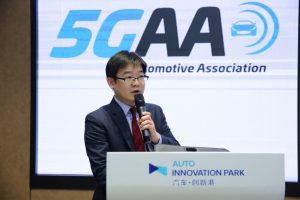
Deputy Director, ITS and Road Safety Division, Road Bureau, Ministry of Land, Infrastructure and Transport, South Korea
Mr. Chang-ki Kim, from the MOLIT (Ministry of Land, Infrastructure, and Transport) explained that his division in Korea is implementing two strategies to promote the commercialisation of Internet of Vehicles. The first strategy consists of focusing on the C-ITS safety aspect by developing and commercialising the RoDAS (Road Driving Assistant Systems) by 2020 in accordance with the National ITS Master Plan. As CAV (Connected and Automated Vehicles) will improve road safety issues under the mixed condition of AV (Automated Vehicles) and LV (Legacy Vehicles) in both highway and urban areas. MOLIT will launch, as its second strategy, the transportation renovation program by promoting and integrating the C-ITS and CAV technologies under their CAD (Connected and Automated Driving) Test-beds. Additionally, he emphasised that deploying those Test-beds in Korea would include the verification of various communication techniques, e.g., C-V2X (LTE, 5G), under the real and dynamic road environment. Mr. Kim expressed his intention to invite all ICT and CAD testing companies to conduct their service applications and to develop their cooperation and sharing models by joining those Test-beds.

5GAA participates in Testbed Visit in Shanghai
Shanghai, China – 16 November 2017 – following the 5G Automotive Association General Assembly Meeting, 5GAA leadership, delegates as well as representatives from Chinese and South Korean government participated in a testbed visit. This practice case was then followed by eight use-cases, demonstrating the success of the LTE-V2X advances. Both of these actions took place at the purpose-built Shanghai district – Testbed F-zone and T-Zone – where the latest developments in vehicle technology are assessed.
1. Realizing LTE-V2X’s capacity: Visit to F-Zone
Huawei LTE-V leader for Research & Development, Mr. Yangyongchao, opened the visit by showcasing LTE-V2X testing reports as well as running a live test result. This series of LTE-V2X performance tests were measured in terms of the technology’s capacity to manage two variables (link level and system level). This analysis was managed by the partnership of China Mobile (CMCC), SIAC and SAIC Motor.
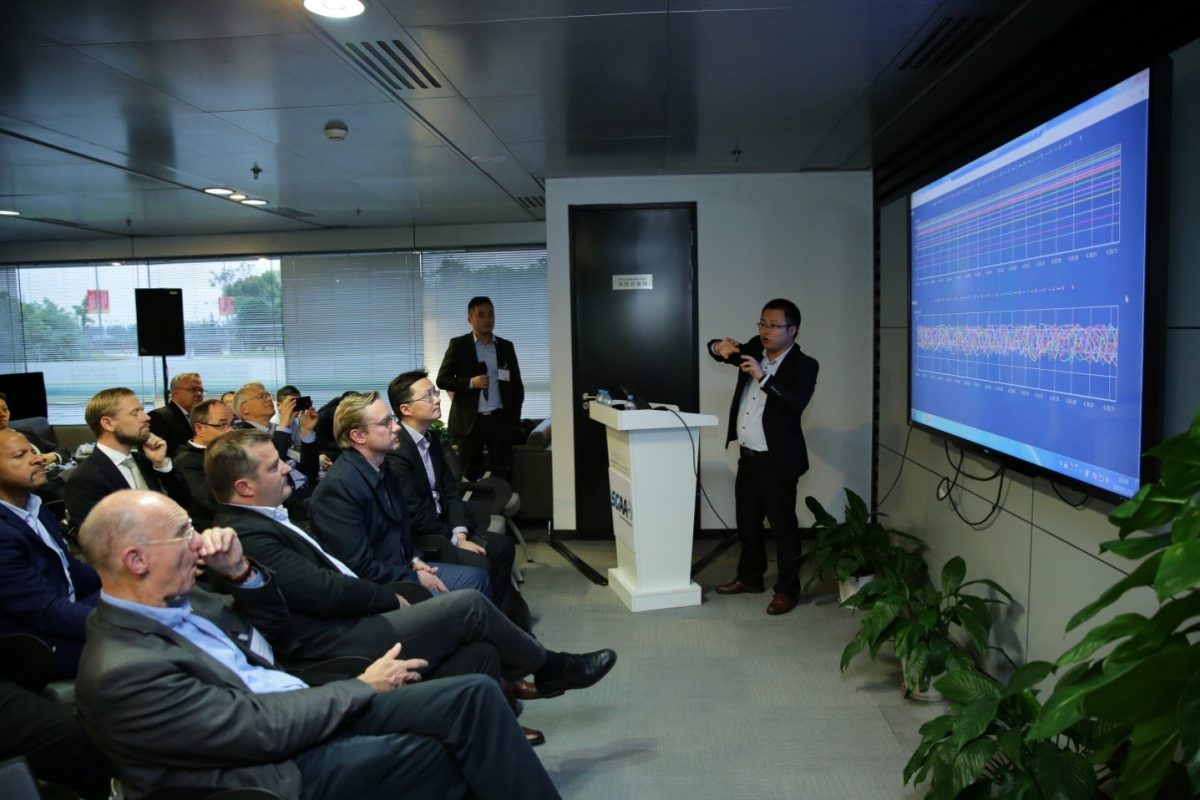
- Link Level Testing: LTE-V2X can support relative vehicle speeds of up to 500km/h, even with correction for timing and frequency errors. LTE-V2X shows excellent link performance with different packet size. The maximum RSU coverage range reaches more than 1km from the test vehicle.
- System Level Testing: 400 vehicles were analysed in this trial environment. Based on this, the capacity and of Vehicle-to-Vehicle and Vehicle- to-Infrastructure is smaller is functional in a range of 20 metres. Messages were transmitted at a success rate of 90% within the demanded communication range in high-density scenarios.
Right after this presentation, SIAC led the delegates to visit the site of F-Zone. Mr. Lilin, director of SIAC explained that F-zone is an enclosed area conducting different scenarios such as parks, urban roads with intersections, simulated highway and related road facilities. Additionally, F-zone is the national level Intelligent and Connected Vehicles test zone equipped with background vehicles, positioning capability and telecommunication infrastructure, including LTE-V2X based RSU, base stations that support both LTE and LTE-V2X, and assisted by operation system.

2. T-Zone visit
After the inspection of F-Zone, delegates visited C-V2X demonstration in T-Zone and observed eight cases in SAIC Motor’s intelligent connected vehicle operated with China Mobile and Huawei. The technology showcased was powered by 5G-V2X. This opened the vehicle up to possibilities such as Tele-Operated Driving, LTE-V2X based Platooning, Forward collision warning, Traffic light speed advisory and Vulnerable Road user warning. Dr. Liu Fen, also explained that with the abundant communications environment in T-zone and more C-V2X functionality can be realised in the future.
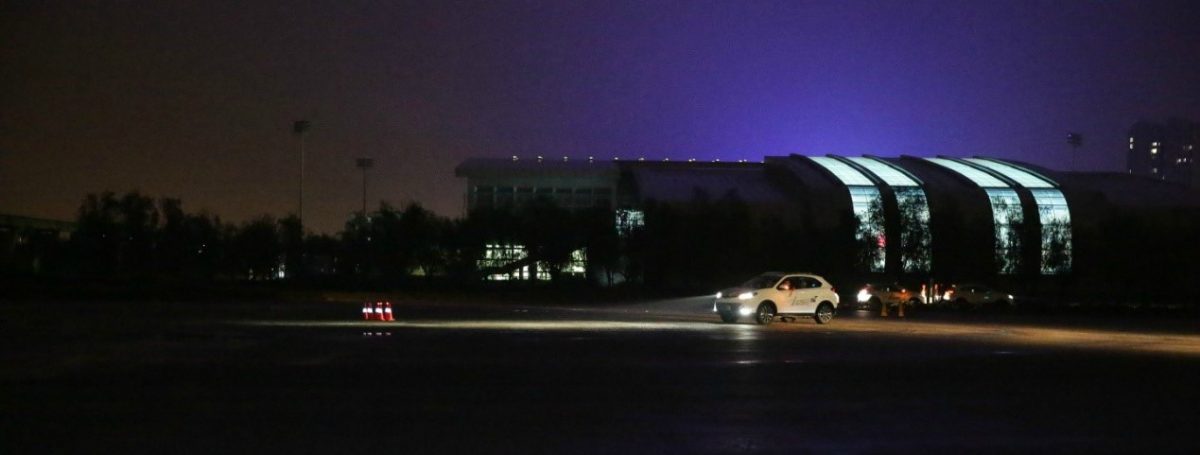
Christoph Voigt, Chairman of 5GAA, views these advances with optimism: “Today’s opportunity to see the fantastic progress from SIAC, SAIC Motor, China Mobile and Huawei is a demonstration of the unlimited possibilities that investing in 5G and LTE -V2X technologies hold. We know that C-V2X technology has the capacity for high-speed, high-density communication between vehicles, infrastructure, and pedestrians. Following further research and collaboration with our members and policy makers in governments around the world, 5GAA is looking forward to introducing this technology globally.”
Dino Flore, Director General of 5GAA is proud of the extensive partnerships that the association has fostered: “5GAA’s aim is to act as a bridge between the automotive and telecommunications industries. I would like to thank our hosts today in Shanghai for their hospitality and proudly showcasing the possibilities promised by C-V2X and 5G. Our organisation is focused on accelerating research and delivering solutions to society to build safer and more sustainable transport for our citizens. Today’s demonstrations are proof of what future holds.”
About the 5GAA
The 5G Automotive Association (5GAA) is a global cross-industry organisation of companies from the automotive, technology and telecommunications industries (ICT), working together to develop end-to-end solutions for future mobility and transportation services. Created in 2016, the Association is comprised of over 67 members which mission is to develop, test and promote communications solutions, initiate their standardization and accelerate their commercial availability and global market penetration to address societal need.

5GAA Launches its Second General Assembly and Working Group Meeting in Shanghai
From 13-17 November 2017, the global members and invited guests of the 5G Automotive Association will assemble in Shanghai, China. The aim of the meeting is to promote the advancement of our mobility ecosystem as well as deepening the association’s collaboration with the Chinese automotive and telecommunications industries.
Over the course of the first three days (13-15 November 2017), 5GAA’s members will collaborate in Working Group meetings. This is a unique opportunity for global leaders in the automotive and telecommunications industries to share innovative practices and drive towards progress.
On the 16th November, The General Assembly will take place: a 1-day meeting where the association’s members will reflect on 2017’s achievements as well as outlining a vision for 2018.
5GAA is honoured to welcome illustrious representatives from Public Institutes to participate in the Asia Pacific Roundtable discussion on Thursday, 16 November 2017. The delegation will include Chinese representatives from the Traffic Management Research Institute of Ministry of Public Security, the Research Institute of Highway Ministry of Transport, the China Academy of Information and Communications Technology of Ministry of Industry and Information Technology, and the Road Bureau of Ministry of Land, Infrastructure, and Transport.
Additionally, South Korean delegates from the Road Bureau of Ministry of Land, Infrastructure, and Transport will participate. This Roundtable promises to generate interesting ideas.
Following the Roundtable discussion and in order to gain a greater practical understanding of the transportation advances in China, 5GAA will visit the Shanghai Testbed with a live demonstration of the power of LTE-V2X and 5G-V2X technology in transport.
Chairman of 5GAA, Christoph Voigt, underlines the importance of choosing China as the location for the Second General Assembly: “We are looking forward to further understanding the progress China can offer to advance 5G transport solutions globally. China is a strong supporter of deepening 5G connectivity to deliver safety and sustainability solutions on our roads. Our discussions with representatives from political and academic institutions in China will offer us an opportunity to gain support around the World and to innovate further, faster and more effectively.”
Since its launch in September 2016, 5GAA has grown exponentially worldwide. Over 60 industry leaders from the automotive, technology and telecommunications industries have teamed up to accelerate C-V2X technology development and its evolution to 5G-V2X for enhanced safety, automated driving, and connected mobility. Together, 5GAA members are building a safer, more sustainable and connected transport ecosystem.



